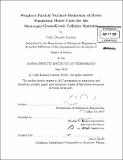Weighted particle variance reduction of Direct Simulation Monte Carlo for the Bhatnagar-Gross-Krook collision operator
Author(s)
Landon, Colin Donald
DownloadFull printable version (2.976Mb)
Alternative title
Weighted particle variance reduction of DSMC for the BGK collision operator
Other Contributors
Massachusetts Institute of Technology. Dept. of Mechanical Engineering.
Advisor
Nicolas G. Hadjiconstantinou.
Terms of use
Metadata
Show full item recordAbstract
Direct Simulation Monte Carlo (DSMC)-the prevalent stochastic particle method for high-speed rarefied gas flows-simulates the Boltzmann equation using distributions of representative particles. Although very efficient in producing samples of the distribution function, the slow convergence associated with statistical sampling makes DSMC simulation of low-signal situations problematic. In this thesis, we present a control-variate-based approach to obtain a variance-reduced DSMC method that dramatically enhances statistical convergence for lowsignal problems. Here we focus on the Bhatnagar-Gross-Krook (BGK) approximation, which as we show, exhibits special stability properties. The BGK collision operator, an approximation common in a variety of fields involving particle mediated transport, drives the system towards a local equilibrium at a prescribed relaxation rate. Variance reduction is achieved by formulating desired (non-equilibrium) simulation results in terms of the difference between a non-equilibrium and a correlated equilibrium simulation. Subtracting the two simulations results in substantial variance reduction, because the two simulations are correlated. Correlation is achieved using likelihood weights which relate the relative probability of occurrence of an equilibrium particle compared to a non-equilibrium particle. The BGK collision operator lends itself naturally to the development of unbiased, stable weight evaluation rules. Our variance-reduced solutions are compared with good agreement to simple analytical solutions, and to solutions obtained using a variance-reduced BGK based particle method that does not resemble DSMC as strongly. A number of algorithmic options are explored and our final simulation method, (VR)2-BGK-DSMC, emerges as a simple and stable version of DSMC that can efficiently resolve arbitrarily low-signal flows.
Description
Thesis (S.M.)--Massachusetts Institute of Technology, Dept. of Mechanical Engineering, 2010. Cataloged from PDF version of thesis. Includes bibliographical references (p. 67-69).
Date issued
2010Department
Massachusetts Institute of Technology. Department of Mechanical EngineeringPublisher
Massachusetts Institute of Technology
Keywords
Mechanical Engineering.